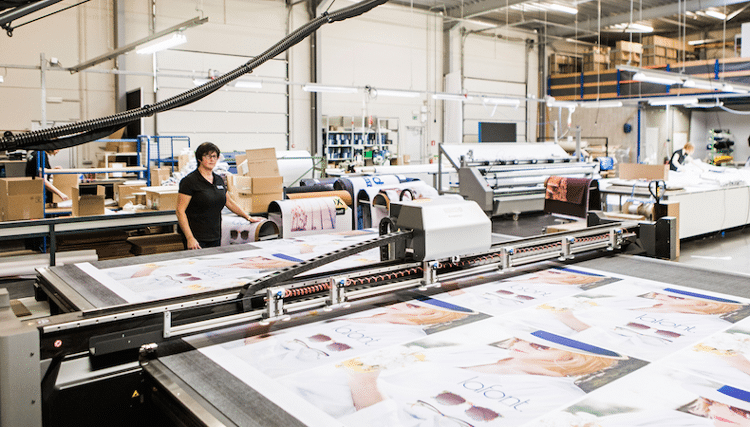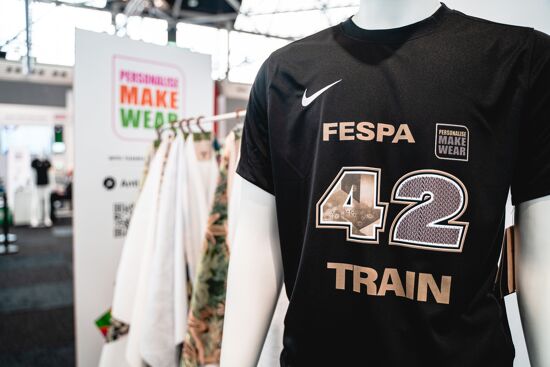Visix relies on Esko to increase throughput

Belgian textile firm Visix has invested in a Kongsberg C64 cutting table to help them increase throughput and remove a finishing bottleneck.
In addition to the 3.2-metre finishing machine that comes with Esko Automation Engine, the manufacturer of flags and banners based in Roeselare, Belgium, has also deployed Esko’s Device Manager.
“The 3.2-metre format for the cutting table is the same width as our grand format printers and downstream calender,” explains Stefaan Devlaminck, who is in charge of production. “We have found the most efficient textile run to be 20 meters long by 3.2 meters wide, and the Kongsberg fits perfectly into that flow.”
Following creation of print files using the Adobe Creative Suite, Visix uses i-cut Preflight, part of Automation Engine, to check for quality and bleed prior to printing. This process tags the file with XML metadata that guides it through the rest of the production process.
“The next step,” Devlaminck states, “is to create a test or proof for customer approval. Automation Engine helps us there as well, automatically generating the proof and establishing the necessary follow-up action items in an automated flow. Once we have customer approval, Automation Engine takes over again, allocating a barcode to the job and routing it to what we call a ‘gang run,’ or a funnel dedicated to each substrate. Files are then automatically nested or imposed to make optimum use of the substrate.”
This process has worked so well for Visix that Devlaminck reports that even though the company is able to produce much more work now, there is actually less overall waste. “And it saves us a huge amount of time,” he adds. “Before, all the nesting was manually calculated which took a lot of time and could be prone to error.”
And the automation doesn’t stop there. By adding Esko Device Manager, Devlaminck and his team benefit from automatic selection of cutting parameters and required cutting blades for each file from the XML metadata, generated by Automation Engine in a sequence that guarantees maximum production efficiency. Compensation settings within Automation Engine to automatically adjust for shrinkage or stretch are also important for the final product quality.
“We’re able to see exactly where in the process a job is at any given point in time, and this is an important benefit to us,” Devlaminck comments. “Device Manager shows us whether the file has been printed, and whether or not it has been cut. This helps us in planning and gives us instant access to information customers may request, related to the job status."
"The bottom line is that we can now seamlessly operate from file acceptance through final delivery in a highly automated fashion. Prepress is no longer a bottleneck, and mistakes are kept at a minimum. These solutions have taken Visix to the next level in terms of throughput, machine utilization, productivity and profitability, enhancing our craftsmanship even more while ensuring the best possible customer service.”
Topics
Interested in joining our community?
Enquire today about joining your local FESPA Association or FESPA Direct
Recent news

Streamlining personalisation with tech: Insights from the SmartHub Conference 2025 speakers
Personalisation Experience 2025 (6 – 9 May 2025, Messe Berlin, Germany) is running its inaugural SmartHub Conference from 6 – 8 May 2025.

Special Effects in DTF: How Neon Inks Are Making Apparel Pop
Neon fluorescent inks are the latest innovation in DTF printing, offering vibrant, eye-catching effects under both daylight and UV light, giving apparel decorators a competitive edge. Testing shows good wash durability, though market perception of added value is still developing. With increasing adoption and ongoing technological advancements, neon represents a significant upgrade for creative customisation.

Unlocking Growth Opportunities in the Printed Personalised Apparel Industry
The printed personalised apparel industry is booming, projected to reach $10.1 billion by 2030. Driven by consumer desire for self-expression and branding needs, technological advancements like DTG/DTF and e-commerce integration are key. Sustainability, eco-friendly materials, and on-demand printing are crucial growth drivers. Businesses leveraging these trends, including AI and social media, have significant commercial potential.

Personalisation: From mass production to print-on-demand
Technological advancements are driving the growing trend of personalisation, fueled by consumer demand for unique products. From packaging campaigns like Share-a-Coke to customised apparel by Nike and Adidas, and AI-powered tools, the shift from mass production to print-on-demand is evident. The SmartHub Conference at the Personalisation Experience from 6 - 8 May will explore these opportunities and challenges for businesses.